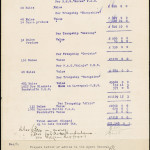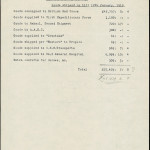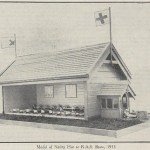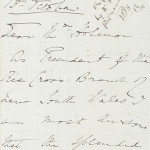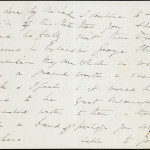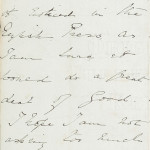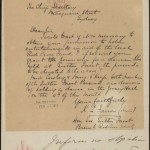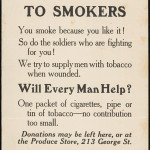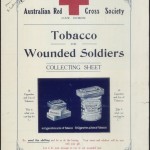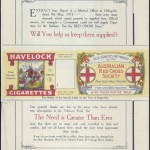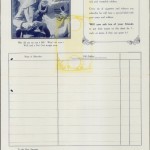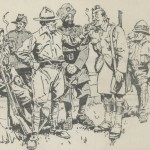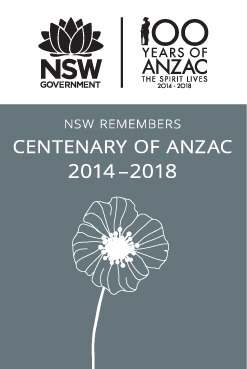NSW Division of the Australian Red Cross Society
Red Cross records in the archives![[Fig. 1] Australian Red Cross Society NSW Division logo. From NRS 12060 [9/4697] letter 15/956.](http://nswanzaccentenary.records.nsw.gov.au/wp-content/uploads/2016/04/NRS120609-469715-956_Red-cross_001a-150x150.jpg)
[Fig. 1] Australian Red Cross Society NSW Division logo. From NRS 12060 [9/4697] letter 15/956.
Premier’s Department
Within the Premier’s Department references to the Red Cross can often be found in NRS 12060 Letters received. The correspondence mostly relates to the first few months of the war in 1914 and into early 1915. For these early months of the war, there are numerous references to Red Cross goods being sent overseas.[Fig. 2] The generosity of the people of NSW was demonstrated by the fact that over £55,000 worth of goods, including motor lorries, clothing, blankets and foodstuffs were shipped out by the end of January 1915. [Fig. 3] (1) A summary list from 12 January 1915 includes a breakdown of where goods were sent, including supplies to the Australian Naval and Expeditionary Force, No. 2 General Hospital, the British Red Cross Society in London and comforts for enlisted nurses.
Motor lorries and ambulances were also donated. For example, the Lloyd Jones family donated an ambulance which was to be inscribed “Lloyd Jones Family, Australian Red Cross, New South Wales Division”. (2) The NSW Division also undertook to equip and maintain three hospital huts at the Netley Military Hospital [Fig. 4], near Southampton in England, using the money raised by the NSW Railways and Tramways’ Officers War Fund. (3)
- [Fig. 2] List of goods sent by NSW Branch or Australian Red Cross Society to London, October 1914. From NRS 12060 [9/4697] letter 15/956.
- [Fig. 3] Summary of goods shipped by NSW Division of Red Cross up till 12 January 1915. From NRS 12060 [9/4697] 15/956.
- [Fig. 4] Model of Netley Hut at RAS Show, 1915. From NRS 15298 Item [23], p.357.
- [Fig. 5] Letter to Premier from Lady Edeline Strickland, 13 October 1914. From NRS 12060 [9/4697] letter 15/956, p.1.
- [Fig. 6] Letter to Premier from Lady Edeline Strickland, 13 October 1914. From NRS 12060 [9/4697] letter 15/956, p.2.
- [Fig. 7] Letter to Premier from Lady Edeline Strickland, 13 October 1914. From NRS 12060 [9/4697] letter 15/956, p.3.
A letter to the Premier from Lady Edeline Strickland, dated 13 October 1914, shows a concern for the work of the Australian Red Cross Society to be recognised and acknowledged in England. [Fig. 5-7] In her letter, Lady Edeline states:
I am most anxious that the splendid work which is being done by the ladies & girls of this state should be fully recognised in England. I consider they are doing a grand work and I feel proud to be associated with such a band of workers. (4)
Premier Holman arranged for the NSW Agent General in London to oversee the delivery of shipments from the NSW Division and organise press releases for the British Press. Holman also agreed that the State government would cover the costs of telegrams to be sent to and from London on behalf of the Red Cross. By 5 February 1915 the cost had amounted to £52. (5)
Chief Secretary
There are many references to the Red Cross and fundraising activities in NRS 905 Main series of letters received and NRS 906 Special bundles. Permission to hold fundraising events was granted by the Chief Secretary and over the course of the war there were many community groups and associations who held a variety of events from fetes to concerts and dances. The Sutton Forest Branch of the Red Cross Society applied and was granted permission to the Chief Secretary to hold a dance in the Jersey Hall on 11 February 1916. [Fig. 8] (6) Patriotic societies and comforts funds undertaking fundraising events had to return audited accounts to the Chief Secretary as attempts were made to keep track of all the money that was being donated. (7)
- [Fig. 8] Letter to Chief Secretary from the Sutton Forest branch of the Red Cross asking for permission to hold a dance. From NRS 905 [5/7480] letter 16/57688.
- [Fig. 9] Red Cross cigarette flyer, 1914. From NRS 905 [5/7260] letter 14/1812.
- [Fig. 10] Australian Red Cross Tobacco for Wounded Soldiers Collecting Sheet. From NRS 905 [5/7481] letter 16/57824, p.1.
- [Fig. 11] Australian Red Cross Tobacco for Wounded Soldiers Collecting Sheet. From NRS 905 [5/7481] letter 16/57824, p.3.
- [Fig. 12] Australian Red Cross Tobacco for Wounded Soldiers Collecting Sheet. From NRS 905 [5/7481] letter 16/57824, p.2.
- [Fig. 13] Sketch of soldiers smoking from The Overseas Club flyer. From NRS 905 [5/7481] letter 16/57824.
One interesting aspect of Red Cross fundraising was the collection and distribution of cigarettes and tobacco. A poster from 1914 encouraged every man to donate “one packet of cigarettes, pipe or tin of tobacco – no contribution too small”. [Fig. 9](8) A Red Cross collecting sheet [Fig. 10-12] from 1916 states:
The Need is Greater Than Ever now that there are so many sick and wounded to help and comfort, and we all know how much the poor boys appreciate their smoke. (9)
Other organisations, like the Southern Cross Tobacco Fund operated by the Over-Seas Club, also collected donations of cigarettes and tobacco for distribution among the troops. Included in one of their flyers is a sketch of soldiers from all over the Commonwealth enjoying a smoke together.[Fig. 13] By the end of the war the Australian Red Cross Society had sent to Australian Imperial Force troops in the Western Front over 10 million cigarettes, 6839 kg of tobacco and over 57,000 pipes. (10)
Related
REFERENCES
(1) State Archives New South Wales, Premier’s Department; NRS 12060 Letters received, [9/4679] letter 15/956 29 January 1915.
(2) NRS 12060 [9/4697] letter 15/956 (letter 15/6300 4 Feb 1915).
(3) NRS 12060 [9/4697] letter 15/956 29 January 1915.
(4) NRS 12060 [9/4697] 15/956 13 October 1913.
(5) NRS 12060 [9/4697] letter 15/956 Cost of telegrams. Outgoing telegrams (in total 8) cost nearly £31 and incoming telegrams (in total 7) cost over £21.
(6) SANSW, Chief Secretary; NRS 905 Main series of letters received, [5/7480] letter 16/57688.
(7) Details of special fundraising days, such as Red Cross Australia Day in 1915 and 1918 can also be located in NRS 906 [5/5293].
(8) NRS 905 [5/7260] 14/1812.
(9) NRS 905 [5/7481] 16/57824.
(10) Scott, Ernest, Official History of Australia in the War of 1914-18, Vol. XI, 7th Ed., 1941 (Ch XXI), https://www.awm.gov.au/collection/RCDIG1069950/, accessed 2 May 2015, p.705.

